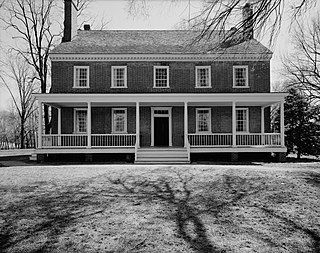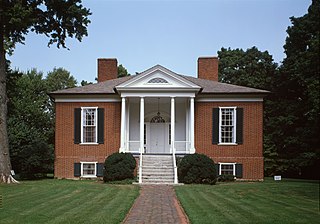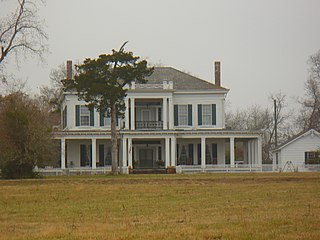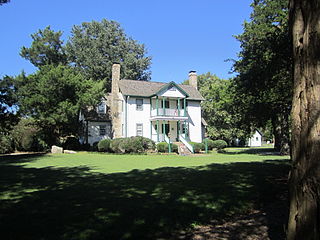
Shirley Plantation is an estate located on the north bank of the James River in Charles City County, Virginia, USA. It is located on scenic byway State Route 5, between Richmond and Williamsburg. It is the oldest active plantation in Virginia and the oldest family-owned business in North America, dating back to 1614 with operations starting in 1648. It used about 70 to 90 enslaved people at a time for forced labor including plowing the fields, cleaning, childcare, and cooking. It was added to the National Register in 1969 and declared a National Historic Landmark in 1970.

Historic Locust Grove is a 55-acre 18th-century farm site and National Historic Landmark situated in eastern Jefferson County, Kentucky. The site is owned by the Louisville Metro government, and operated as a historic interpretive site by Historic Locust Grove, Inc.

Farmington, an 18-acre (7.3 ha) historic site in Louisville, Kentucky, was once the center of a hemp plantation owned by John and Lucy Speed. The 14-room, Federal-style brick plantation house was possibly based on a design by Thomas Jefferson and has several Jeffersonian architectural features. As many as 64 African Americans were enslaved by the Speed family at Farmington.

Stagville Plantation is located in Durham County, North Carolina. With buildings constructed from the late 18th century to the mid-19th century, Stagville was part of one of the largest plantation complexes in the American South. The entire complex was owned by the Bennehan, Mantack and Cameron families; it comprised roughly 30,000 acres (120 km2) and was home to almost 900 enslaved African Americans in 1860.

Cedar Creek and Belle Grove National Historical Park became the 388th unit of the United States National Park Service when it was authorized on December 19, 2002. The National Historical Park was created to protect several historically significant locations in the Shenandoah Valley of Northern Virginia, notably the site of the American Civil War Battle of Cedar Creek and the Belle Grove Plantation.

The Jarrell Plantation State Historic Site is a former cotton plantation and state park in Juliette, Georgia, United States. Founded as a forced-labor farm worked by the Jarrell family and the African American people they enslaved, the site stands today as one of the best-preserved examples of a "middle class" Southern plantation. The Jarrell Plantation's buildings and artifacts all came from the Jarrell family, who farmed the land for over 140 years. Located in the red clay hills of the Georgia piedmont, It was added to the National Register of Historic Places in 1973. It is a Georgia state park in Jones County.

Wye House is a historic residence and former headquarters of a historic plantation house northwest of Easton in rural Talbot County, Maryland. Built in 1781–1784, it is a high-quality and well-proportioned example of a wooden-frame Southern plantation house. It was designated a National Historic Landmark in 1970.

Church Hill is a small unincorporated community in Jefferson County, Mississippi, United States. It is located eight miles east of the Mississippi River and approximately 18 miles north of Natchez at the intersection of highway 553 and Church Hill Road. Church Hill was a community of wealthy cotton planters and enslaved people before the American Civil War. Soil erosion, which had been going on since well before the Civil War, caused the area to decline into a poor farming community with none of the land under cultivation by 1999. The area is remarkable because its antebellum buildings are mostly intact with few modern buildings having been built.

Cedar Grove Plantation, also known as the Charles Walker House, is a Greek Revival plantation house located near Faunsdale, Marengo County, Alabama. It is notable in having been the residence of Nicola Marschall for a brief period while the Walker family owned the property. The house was added to the National Register of Historic Places on 13 July 1993 as a part of the Plantation Houses of the Alabama Canebrake and Their Associated Outbuildings Multiple Property Submission.

Nottoway Plantation, also known as Nottoway Plantation House is located near White Castle, Louisiana, United States. The plantation house is a Greek Revival- and Italianate-styled mansion built by craftsmen along with slaves for John Hampden Randolph in 1859, and is the largest extant antebellum plantation house in the South with 53,000 square feet (4,900 m2) of floor space.

Tuckahoe, also known as Tuckahoe Plantation, or Historic Tuckahoe is located in Tuckahoe, Virginia on Route 650 near Manakin, Virginia overlapping both Goochland and Henrico counties, six miles from the town of the same name. Built in the first half of the 18th century, it is a well-preserved example of a colonial plantation house, and is particularly distinctive as a colonial prodigy house. Thomas Jefferson is also recorded as having spent some of his childhood here. It was declared a National Historic Landmark in 1969.

The Bennett Bunn Plantation is a historic farm near Zebulon, North Carolina, a suburb of Raleigh. The plantation, located beside US 264 in eastern Wake County, consists of a two-story house, built in 1833, barns, and 162 acres (66 ha) of farmland and forests. The property was owned by generations of the Bunn family until 2000 when Grace Hutchins, great-granddaughter of Bennet Bunn, sold the property for $1.9 million. The home is still used as a private residence and was listed on the National Register of Historic Places in February 1986.

Rippavilla Plantation, also known as Meadowbrook and Nathaniel Cheairs House, is a former plantation, historic house and museum, located in Spring Hill, Tennessee. This plantation had been worked by enslaved Black people for many years. It is open to visitors as a historic house museum.

Cedar Crest, also known as Cedar Crest Farms, is a Greek Revival plantation house located near Faunsdale, Alabama. It was built for Kimbrough Cassels Dubose in 1850 by Albert Prince, a slave. Dubose, born in Darlington District, South Carolina was educated at the preparatory school of Prof. Stafford who later was of the faculty of the University of Alabama. His wife was Miss Elizabeth Boykin Witherspoon also of Darlington District, South Carolina, and they had seven sons and four daughters: John Witherspoon, James Henry, Jr., Eugene, Nicholas William, Francis Marion, Lemuel Benton and Edwin Dargan-the daughters Louisa, Rosalie, Augusta and Adele. The plantation was worked by the forced labor of as many as 130 enslaved persons. The house is one-and-a-half stories with side gables, but has been simplified. It originally had side wings, with adjoining porches across the front. These were removed in 1939, leaving the small central front portico. Another historic plantation house, Altwood, was moved from a nearby location to the Cedar Crest grounds in 1988. The house was added to the National Register of Historic Places on August 5, 1993, as a part of the Plantation Houses of the Alabama Canebrake and Their Associated Outbuildings Multiple Property Submission.

Hawthorne, also known as the Browder Place, is a historic Italianate plantation house and historic district in Prairieville, Alabama, USA. This area of Hale County was included in Marengo County before the creation of Hale in 1867. Hawthorne is included in the Plantation Houses of the Alabama Canebrake and Their Associated Outbuildings Multiple Property Submission. It was added to the National Register of Historic Places on July 7, 1994, due to its architectural significance.

Belle Grove Plantation is a late-18th-century plantation house and estate in the northern Shenandoah Valley of Virginia, USA. It is situated in Frederick County, about a mile southwest of Middletown.

The Lynnhaven House, also Wishart–Boush House, Wishart House, and Boush House, which was built circa 1725, is an example of 18th century Tidewater Virginia vernacular architecture and is located in Virginia Beach, Virginia. Although it was founded by the Thelaball family, it is sometimes referred to as the Boush House or the Wishart House. The house was given the name the Lynnhaven House due to its close proximity to the Lynnhaven River, which flows on the same property. Originally, the home, located at 4405 Wishart Road, stood on a 250-acre plantation. Now, it is located on five and a half acres.
Rufus Reid (1797–1854) was an American plantation owner, businessman and politician from North Carolina.

The Cedars is a private home in Clinton, Mississippi. Built around 1839, it is listed on the National Register of Historic Places, and is one of the oldest extant houses in Hinds County.

The Poplar Grove Plantation, also once known as Popular Grove Plant and Refining Company, is a historic building, site and cemetery, the plantation is from the 1820s and the manor house was built in 1884, located in Port Allen in West Baton Rouge Parish, Louisiana. The site served as a sugar plantation worked by enslaved African Americans, starting in the 1820s by James McCalop. Starting in 1903, the site was owned by the Wilkinson family for many generations.



















